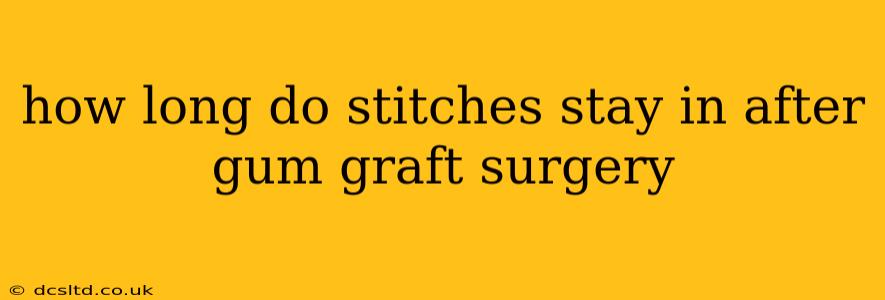Gum graft surgery, also known as gingival grafting, is a common procedure used to treat gum recession, which exposes the roots of teeth and can lead to sensitivity, increased risk of decay, and bone loss. A crucial part of the healing process is the removal of the stitches. But just how long do you have to wait? The answer isn't a simple number, as it depends on several factors. This comprehensive guide will explore the typical timeline, influencing factors, and what to expect during recovery.
What is Gum Graft Surgery?
Before diving into stitch removal, let's briefly understand the procedure. Gum graft surgery involves taking a small piece of gum tissue from another area in your mouth (usually the palate) or from a donor source and grafting it onto the area with gum recession. This helps to cover the exposed roots and restore a healthy gum line. The surgeon then secures the graft using dissolvable or non-dissolvable sutures (stitches).
How Long Do Stitches Typically Stay In?
Generally, stitches after gum graft surgery are removed after 7 to 10 days. However, this is just an average. Your dentist or periodontist will schedule a follow-up appointment specifically to remove the sutures. They'll assess the healing progress of your gums and make the determination based on your individual case.
What Factors Influence Stitch Removal Timing?
Several factors can affect how long your stitches remain in place:
- Type of Sutures: Dissolvable stitches will naturally break down and dissolve over time, often eliminating the need for removal. Non-dissolvable stitches, however, require manual removal by your dentist.
- Healing Rate: Everyone heals at a different pace. If your gums are healing slower than expected, your dentist might delay stitch removal to ensure proper healing and minimize the risk of complications.
- Surgical Technique: The specific surgical technique used can influence healing time and thus the timing of stitch removal.
- Post-Operative Care: Following your dentist's post-operative instructions diligently can significantly impact your healing and may contribute to quicker stitch removal.
What Happens During Stitch Removal?
Stitch removal is a relatively quick and painless procedure. Your dentist will use small scissors to carefully snip the stitches, and you may feel a slight tug or pressure. The area may bleed slightly, but this is usually minimal and easily controlled with pressure.
What if My Stitches Come Out Early?
In some cases, stitches may loosen or come out prematurely. If this happens, contact your dentist immediately. Don't attempt to remove them yourself. They can assess the situation and advise on the best course of action.
What Happens After Stitch Removal?
After stitch removal, you'll likely have some minor discomfort and swelling, but this should gradually subside. Your dentist will give you instructions on how to care for the healing site, including oral hygiene practices and any necessary follow-up appointments. Remember that your gums will continue to heal, even after the stitches are removed. Full healing can take several weeks.
Are there different types of gum grafts?
Yes, there are several different types of gum grafts, each with its own advantages and disadvantages. The type of graft used can also influence the healing time and stitch removal timeline. Your dentist will determine the best type of graft for your specific needs based on factors such as the extent of gum recession and the overall health of your mouth.
How long does it take to fully heal after a gum graft?
Complete healing after a gum graft can take several weeks or even months. While the initial healing and stitch removal are relatively quick, the gums need time to fully integrate the grafted tissue and achieve optimal stability. Regular follow-up appointments with your dentist are crucial to monitor the healing process.
By understanding the factors involved and following your dentist's instructions carefully, you can ensure a smooth recovery process after your gum graft surgery. Remember to contact your dental professional if you have any concerns or complications during the healing period.
